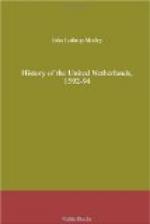What would become of the world-empire, where was the great king—not of Spain alone, nor of France alone—but the great monarch of all Christendom, to plant his throne securely, if his Frisian strongholds, his most important northern outposts, were to fall before an almost beardless youth at the head of a handful of republican militia?
Verdugo did his best, but the best was little. The Spanish and Italian legions had been sent out of the Netherlands into France. Many had died there, many were in hospital after their return, nearly all the rest were mutinous for want of pay.
On the 16th August, Maurice formally summoned Coeworden to surrender. After the trumpeter had blown thrice; Count Van den Berg, forbidding all others, came alone upon the walls and demanded his message. “To claim this city in the name of Prince Maurice of Nassau and of the States-General,” was the reply.
“Tell him first to beat down my walls as flat as the ditch,” said Van den Berg, “and then to bring five or six storms. Six months after that I will think whether I will send a trumpet.”
The prince proceeded steadily with his approaches, but he was infinitely chagrined by the departure out of his camp of Sir Francis Vere with his English contingent of three regiments, whom Queen Elizabeth had peremptorily ordered to the relief of King Henry in Brittany.
Nothing amazes the modern mind so much as the exquisite paucity of forces and of funds by which the world-empire was fought for and resisted in France, Holland, Spain, and England. The scenes of war were rapidly shifted—almost like the slides of a magic-lantern—from one country to another; the same conspicuous personages, almost the same individual armies, perpetually re-appearing in different places, as if a wild phantasmagoria were capriciously repeating itself to bewilder the imagination. Essex, and Vere, and Roger Williams, and Black Norris-Van der Does, and Admiral Nassau, the Meetkerks and Count Philip-Farnese and Mansfeld, George Basti, Arenberg, Berlaymont, La None and Teligny, Aquila and Coloma—were seen alternately fighting, retreating, triumphant, beleaguering, campaigning all along the great territory which extends from the Bay of Biscay to the crags of Brittany, and across the narrow seas to the bogs of Ireland, and thence through the plains of Picardy and Flanders to the swamps of Groningen and the frontiers of the Rhine.
This was the arena in which the great struggle was ever going on, but the champions were so few in number that their individual shapes become familiar to us like the figures of an oft-repeated pageant. And now the withdrawal of certain companies of infantry and squadrons of cavalry from the Spanish armies into France, had left obedient Netherland too weak to resist rebellious Netherland, while, on the other hand, the withdrawal of some twenty or thirty companies of English auxiliaries—most hard-fighting veterans it is true, but very few in number—was likely to imperil the enterprise of Maurice in Friesland.




